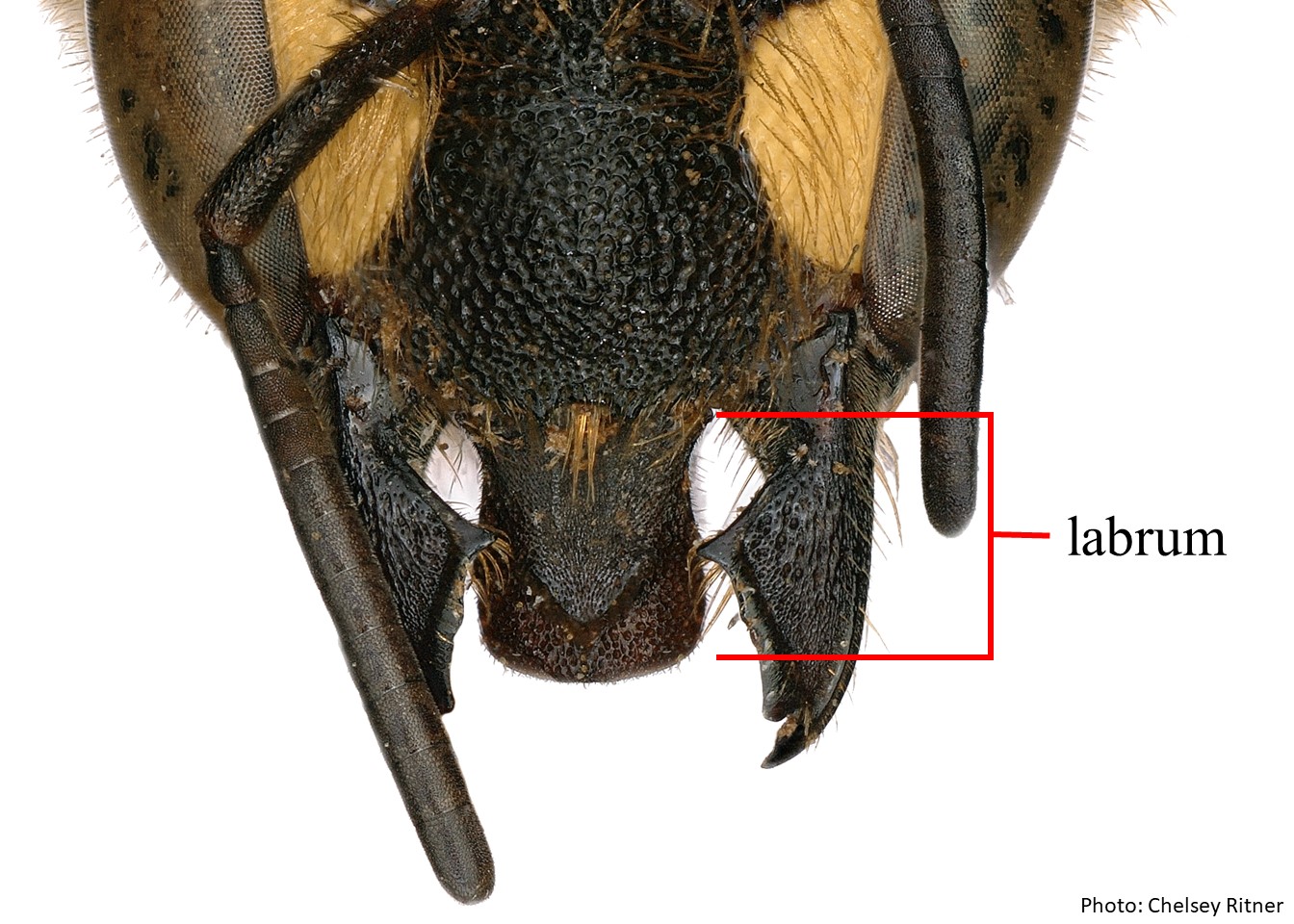Family: Megachilidae
Subfamily: Megachilinae
Tribe: Anthidiini
Genus: Anthidium Fabricius, 1804
Subgenus: A. (Anthidium) Fabricius, 1804
Species: Anthidium sonorense Cockerell, 1923
Common name: none
Anthidium (Anthidium) sonorense are black with brown coloration on the antennal flagellumflagellum:
any segment of the antenna past the scape and pedicel , tegulategula:
, tegulategula:
the usually oval, small shield-like structure carried at the extreme base of the wing where it attaches to the body discs, legs, tarsitarsi:
the group of segments at the end of the leg following the tibia
, and sternasterna:
the plates on the underside of the abdomen, often abbreviated when referring to a specific segment to S1, S2, S3, S4, S5, S6, S7, or S8
 , and yellow maculations (Gonzalez and Griswold 2013Gonzalez and Griswold 2013:
, and yellow maculations (Gonzalez and Griswold 2013Gonzalez and Griswold 2013:
Gonzalez, V.H. and T.L. Griswold. 2013. Wool carder bees of the genus Anthidium in the Western Hemisphere (Hymenoptera: Megachilidae): diversity, host plant associations, phylogeny, and biogeography. Zoological Journal 168: 221ndash;425.). Females have white pubescencepubescence:
short, fine hair
, and a body length of 9.2–12.3 mm. Male pubescencepubescence:
short, fine hair
is longer and denser than that of females. Males range in body length from 11.0–12.3 mm (Gonzalez and Griswold 2013Gonzalez and Griswold 2013:
Gonzalez, V.H. and T.L. Griswold. 2013. Wool carder bees of the genus Anthidium in the Western Hemisphere (Hymenoptera: Megachilidae): diversity, host plant associations, phylogeny, and biogeography. Zoological Journal 168: 221ndash;425.).
(modified from Gonzalez and Griswold 2013Gonzalez and Griswold 2013:
Gonzalez, V.H. and T.L. Griswold. 2013. Wool carder bees of the genus Anthidium in the Western Hemisphere (Hymenoptera: Megachilidae): diversity, host plant associations, phylogeny, and biogeography. Zoological Journal 168: 221ndash;425.)
 lacks basalbasal:
lacks basalbasal: is straight with translucent preapicalpreapical:
is straight with translucent preapicalpreapical: with median apicalapical:
with median apicalapical: .
. apicalapical:
apicalapical: with laterallateral:
with laterallateral: is apicallyapically:
is apicallyapically: has a short, broad apicalapical:
has a short, broad apicalapical: laterallateral:
laterallateral: median spine.
median spine. laterallateral:
laterallateral:Anthidium sonorense may be confused with A. paroselaebecause they both have a shiny fronsfrons:
the area between the antennae and ocelli on the bee's head, a carinacarina:
a clearly defined ridge or keel, not necessarily high or acute; usually appears on bees as simply a raised line
on the anterioranterior:
toward the head or on the head side of a segment being described
margin of the hind tibiatibia:
the segment of the leg, between the femur and the tarsus, and weakly raised tergal discs. Anthidium sonorense can be differentiated from A. paroselaefemales by the longer apicalapical:
near or at the apex or end of any structure
mandibular tooth, the presence of two submedian yellow bandsbands:
usually referring to bands of hair or bands of color that traverse across an abdominal segment
on the scutumscutum:
the large segment on top of the thorax located between the wings and behind the head
, and the shape of the apicalapical:
near or at the apex or end of any structure
margin of T6T6:
the segments on the top side of the abdomen, often abbreviated when referring to a specific segment to T1, T2, T3, T4, T5, T6, or T7 . Male A. sonorense can be differentiated from A. paroselae by the shapes of S6S6:
. Male A. sonorense can be differentiated from A. paroselae by the shapes of S6S6:
the plates on the underside of the abdomen, often abbreviated when referring to a specific segment to S1, S2, S3, S4, S5, S6, S7, or S8
 , S7S7:
, S7S7:
the plates on the underside of the abdomen, often abbreviated when referring to a specific segment to S1, S2, S3, S4, S5, S6, S7, or S8
 , and T7T7:
, and T7T7:
the segments on the top side of the abdomen, often abbreviated when referring to a specific segment to T1, T2, T3, T4, T5, T6, or T7 (Gonzalez and Griswold 2013Gonzalez and Griswold 2013:
(Gonzalez and Griswold 2013Gonzalez and Griswold 2013:
Gonzalez, V.H. and T.L. Griswold. 2013. Wool carder bees of the genus Anthidium in the Western Hemisphere (Hymenoptera: Megachilidae): diversity, host plant associations, phylogeny, and biogeography. Zoological Journal 168: 221ndash;425.).
Anthidium sonorense adults have been recorded in flight from April to June, with with peak activity occurring from April to May (Gonzalez and Griswold 2013Gonzalez and Griswold 2013:
Gonzalez, V.H. and T.L. Griswold. 2013. Wool carder bees of the genus Anthidium in the Western Hemisphere (Hymenoptera: Megachilidae): diversity, host plant associations, phylogeny, and biogeography. Zoological Journal 168: 221ndash;425.).
Anthidium sonorense is a generalist that has been observed visiting a variety of species within Aizoaceae, Fabaceae, and Zygophyllaceae (Gonzalez and Griswold 2013Gonzalez and Griswold 2013:
Gonzalez, V.H. and T.L. Griswold. 2013. Wool carder bees of the genus Anthidium in the Western Hemisphere (Hymenoptera: Megachilidae): diversity, host plant associations, phylogeny, and biogeography. Zoological Journal 168: 221ndash;425.).
Nesting behavior is unknown.
Anthidium sonorense occur in southern California in the U.S. (Gonzalez and Griswold 2013Gonzalez and Griswold 2013:
Gonzalez, V.H. and T.L. Griswold. 2013. Wool carder bees of the genus Anthidium in the Western Hemisphere (Hymenoptera: Megachilidae): diversity, host plant associations, phylogeny, and biogeography. Zoological Journal 168: 221ndash;425.). In Mexico, they occur in Baja California Sur, Baja California, and Sonora. They are found primarily in the Sonoran and Mojave Deserts, but are absent in the Chihuahuan Desert. They are mostly found below sea level (Gonzalez and Griswold 2013Gonzalez and Griswold 2013:
Gonzalez, V.H. and T.L. Griswold. 2013. Wool carder bees of the genus Anthidium in the Western Hemisphere (Hymenoptera: Megachilidae): diversity, host plant associations, phylogeny, and biogeography. Zoological Journal 168: 221ndash;425.).
Distribution map generated by Discover Life -- click on map for details, credits, and terms of use.
Gonzalez, V.H. and T.L. Griswold. 2013. Wool carder bees of the genus Anthidium in the Western Hemisphere (Hymenoptera: Megachilidae): diversity, host plant associations, phylogeny, and biogeography. Zoological Journal of the Linnean Society 168: 221-425.